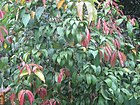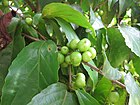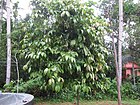Note: This is a project under development. The articles on this wiki are just being initiated and broadly incomplete. You can Help creating new pages.
Difference between revisions of "Flacourtia jangomas"
(→Commonly seen growing in areas) |
|||
| Line 2: | Line 2: | ||
'''Flacourtia jangomas''' is a small, spiny, evergreen tree that branches from very low down on the bole. It can grow up to 10 metres tall, but is usually smaller. The plant is cultivated, especially in tropical Asia but also in Tropical America, for its edible fruit. | '''Flacourtia jangomas''' is a small, spiny, evergreen tree that branches from very low down on the bole. It can grow up to 10 metres tall, but is usually smaller. The plant is cultivated, especially in tropical Asia but also in Tropical America, for its edible fruit. | ||
==Uses== | ==Uses== | ||
| − | {{Uses|Diarrhoea}}, {{Uses|Dysentery}}. | + | {{Uses|Diarrhoea}}, {{Uses|Dysentery}}.<ref name="Uses"/> |
==Parts Used== | ==Parts Used== | ||
Revision as of 11:26, 8 May 2020
Flacourtia jangomas is a small, spiny, evergreen tree that branches from very low down on the bole. It can grow up to 10 metres tall, but is usually smaller. The plant is cultivated, especially in tropical Asia but also in Tropical America, for its edible fruit.
Contents
- 1 Uses
- 2 Parts Used
- 3 Chemical Composition
- 4 Common names
- 5 Properties
- 6 Habit
- 7 Identification
- 8 List of Ayurvedic medicine in which the herb is used
- 9 Where to get the saplings
- 10 Mode of Propagation
- 11 How to plant/cultivate
- 12 Commonly seen growing in areas
- 13 Photo Gallery
- 14 References
- 15 External Links
Uses
Parts Used
Chemical Composition
Common names
| Language | Common name |
|---|---|
| Kannada | |
| Hindi | |
| Malayalam | |
| Tamil | |
| Telugu | |
| Marathi | |
| Gujarathi | |
| Punjabi | |
| Kashmiri | |
| Sanskrit | |
| English |
Properties
Reference: Dravya - Substance, Rasa - Taste, Guna - Qualities, Veerya - Potency, Vipaka - Post-digesion effect, Karma - Pharmacological activity, Prabhava - Therepeutics.
Dravya
Rasa
Guna
Veerya
Vipaka
Karma
Prabhava
Habit
[[:Category:Habit - |]]
Identification
Leaf
| Kind | Shape | Feature |
|---|---|---|
Flower
| Type | Size | Color and composition | Stamen | More information |
|---|---|---|---|---|
| {{{5}}} |
Fruit
| Type | Size | Mass | Appearance | Seeds | More information |
|---|---|---|---|---|---|
Other features
List of Ayurvedic medicine in which the herb is used
Where to get the saplings
Mode of Propagation
How to plant/cultivate
A plant of the hot, humid, tropical lowlands.[4]
Commonly seen growing in areas
Photo Gallery
References
- ↑ Indian Medicinal Plants by C.P.Khare
- ↑ [Chemistry]
- ↑ [Morphology]
- ↑ Cultivation
External Links
Categories:
- Ayurvedic Herbs known to be helpful to treat Diarrhoea
- Ayurvedic Herbs known to be helpful to treat Dysentery
- Herbs with Fruits used in medicine
- Herbs with Young shoots used in medicine
- Habit -
- Index of Plants which can be propagated by Seeds
- Index of Plants which can be propagated by Layering
- Index of Plants which can be propagated by Grafting
- Herbs that are commonly seen in the region of Truly wild state
- Herbs
- Pages without herbs images





